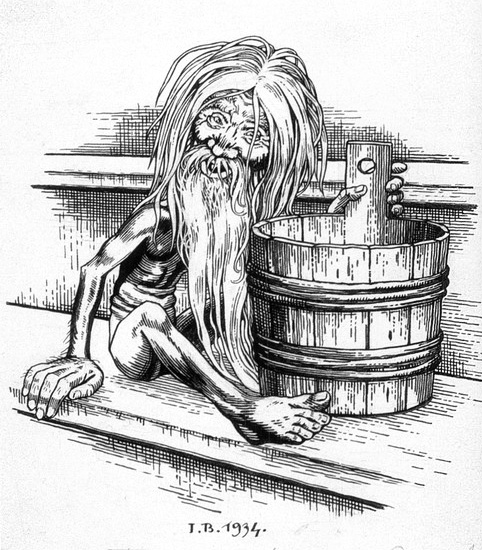Bannik on:
[Wikipedia]
[Google]
[Amazon]
 The Bannik () is a
The Bannik () is a
 The Bannik () is a
The Bannik () is a bathhouse
Bathhouse may refer to:
* Public baths, public facilities for bathing
* Gay bathhouse
A gay bathhouse, also known as a gay sauna or a gay steambath, is a public bath targeted towards Gay men, gay and Bisexuality, bisexual men. In gay slang, a ...
('' banya'') spirit in Slavic mythology
Slavic paganism, Slavic mythology, or Slavic religion refer to the Religion, religious beliefs, myths, and ritual practices of the Slavs before Christianisation of the Slavs, Christianisation, which occurred at various stages between the 8th and ...
.Alexinsky, G. ''Slavonic Mythology'' in ''New Larousse Encyclopedia of Mythology''. Prometheus Press, 1973, p. 287-88 He is usually described as a small, naked old man with a long beard, his body covered in the birch leaves left over from well used bath broom
A sauna whisk (; or ; ; ; rus, банный веник, p=ˈbanːɨj ˈvʲenʲɪk) or bath broom is a besom, or broom, used for bathing in sauna
A sauna (, ) is a room or building designed as a place to experience dry or wet heat sess ...
s. Many accounts also claim that he is a shapeshifter and can appear as a local person to someone who stumbles across him, or even as a stone or coal in the oven heating the bathhouse. Slavic bathhouses resemble sauna
A sauna (, ) is a room or building designed as a place to experience dry or wet heat sessions or an establishment with one or more of these facilities. The steam and high heat make the bathers perspire. A thermometer in a sauna is used to meas ...
s, with an inner steaming room and an outer changing room. A place where women gave birth
Birth is the act or process of bearing or bringing forth offspring, also referred to in technical contexts as parturition. In mammals, the process is initiated by hormones which cause the muscular walls of the uterus to contract, expelling the f ...
and practiced divination
Divination () is the attempt to gain insight into a question or situation by way of an occultic ritual or practice. Using various methods throughout history, diviners ascertain their interpretations of how a should proceed by reading signs, ...
s, the bathhouse was strongly endowed with vital forces. The third firing (or fourth, depending on tradition) was reserved for the bannik, and, given his inclination to invite demons and forest spirits to share his bath, no Christian
A Christian () is a person who follows or adheres to Christianity, a Monotheism, monotheistic Abrahamic religion based on the life and teachings of Jesus in Christianity, Jesus Christ. Christians form the largest religious community in the wo ...
images were allowed lest they offend the occupants. If disturbed by an intruder while washing, the bannik might pour boiling water over him, or even strangle him.
There were several rituals performed in order to keep the bannik happy and peaceful. The most common occurred during the steaming/firing that was reserved for the spirit itself or upon the quitting of the banya for the night; offerings of fir branches, water and soap were left, capped by a formal thank you uttered aloud. The bannik was often blamed for anything that went wrong within the bathhouse, so if the structure burned down (which they often did), it was believed the spirit had been affronted in some way. In order to appease the bannik, upon the rebuilding of a banya, a black hen would be suffocated, left unplucked and buried beneath the building's threshold. The people performing this ritual would end it by bowing and backing away from the threshold, while reciting appropriate incantations.
The banya was considered a liminal space among Slavic peasants and thus, was considered "unclean", or a place of possible spiritual danger. Despite this, most births occurred inside the banya and it was believed that the bannik was not truly happy or settled until a child was born within his domain.
The bannik had the ability to predict the future. One consulted him by standing with one's back exposed in the half-open door of the bath. The bannik would gently stroke one's back if all boded well; but if trouble lay ahead, he would strike with his claws.
See also
* ''Akaname
The is a Japanese ''yōkai'' depicted in Toriyama Sekien's 1776 book ''Gazu Hyakki Yagyō'', with its precursor or equivalent documented earlier in 1686.
These beings presumably lick the filth and scum that collect in bathtubs and bathrooms. ...
''
* Deities of Slavic religion
The pagan Slavs were polytheistic, which means that they worshipped many gods and goddesses. The gods of the Slavs are known primarily from a small number of chronicles and letopises, or not very accurate Christian sermons against paganism. Add ...
* Domovoy
In the Slavic religious tradition, Domovoy (, literally " he oneof the household"; also spelled ''Domovoi'', ''Domovoj'', and known as , (''Domovik''), (''Domovyk'') and (''Damavik'')) is the household spirit of a given kin. According to th ...
* Komi mythology
* ''Ovinnik
The Ovinnik (), Joŭnik or Jovnik () is a malevolent spirit of the Threshing floor, threshing house in Slavic folklore whose name derived from ''ovin'' 'barn'.Dixon-Kennedy, Mike (1998). ''Encyclopedia of Russian and Slavic Myth and Legend''. San ...
''
* Slavic creatures of folklore
The pagan Slavs were polytheistic, which means that they worshipped many gods and goddesses. The gods of the Slavs are known primarily from a small number of chronicles and letopises, or not very accurate Christian sermons against paganism. Add ...
References
{{Fairies Slavic tutelary deities